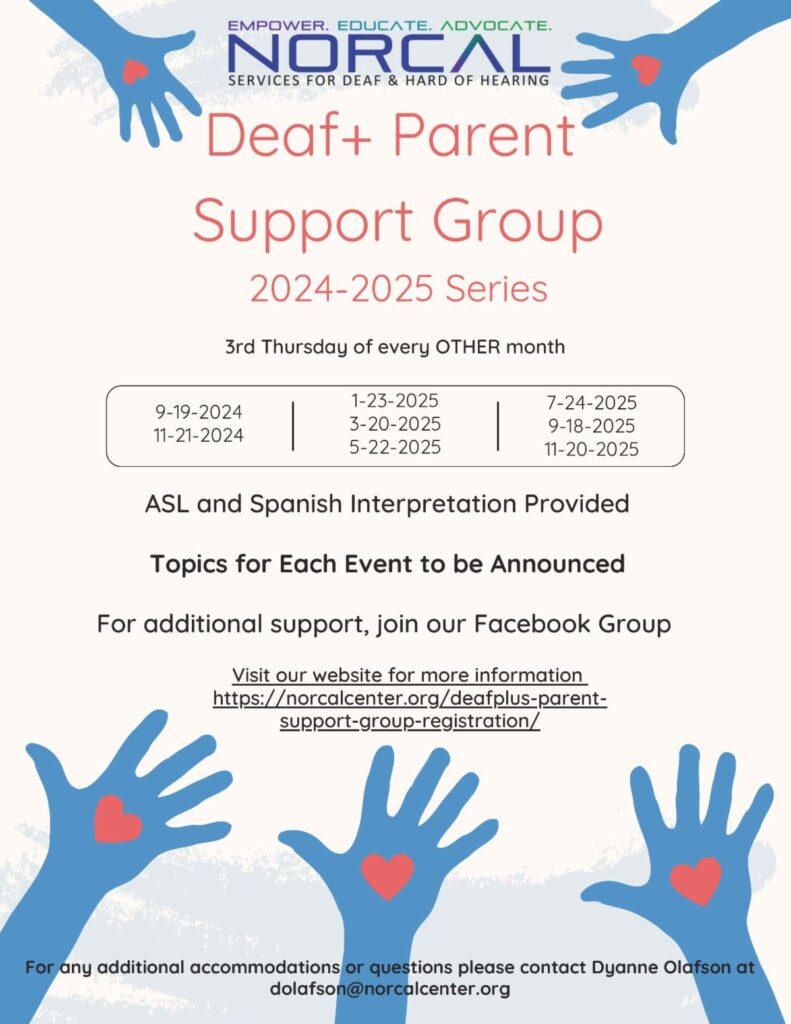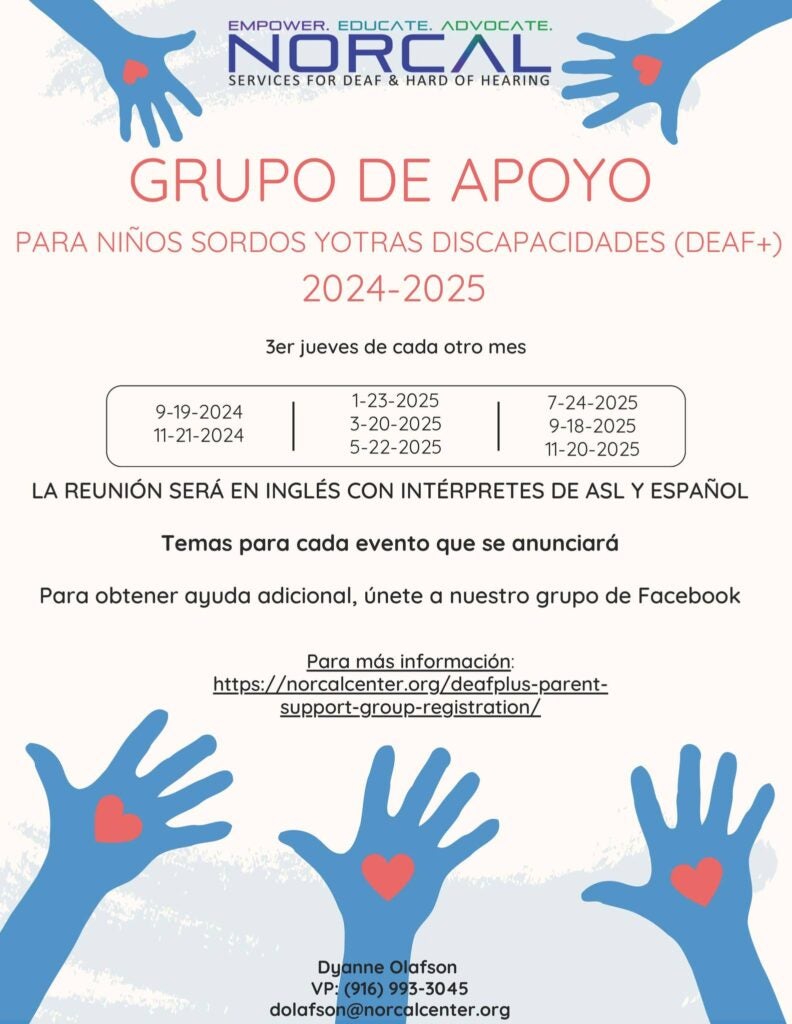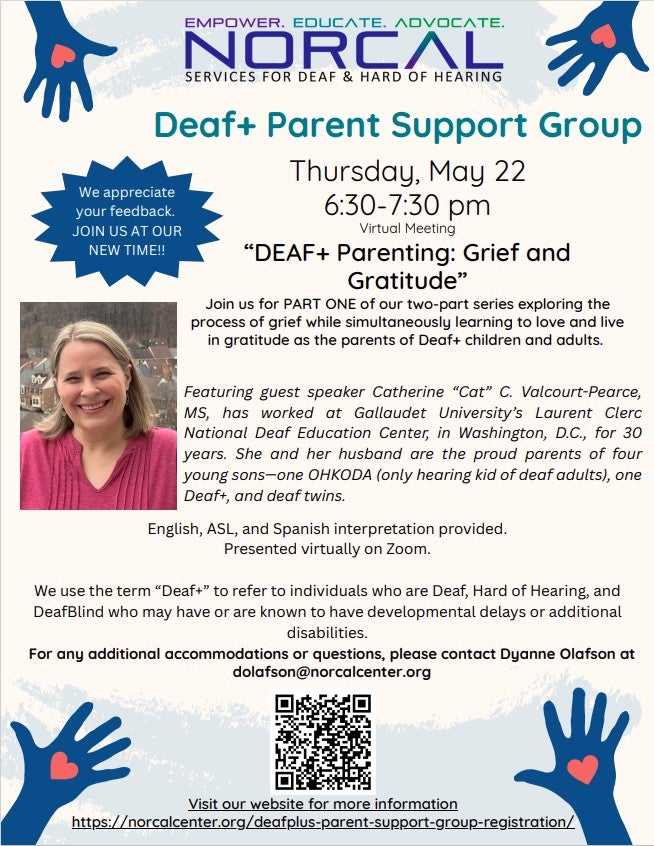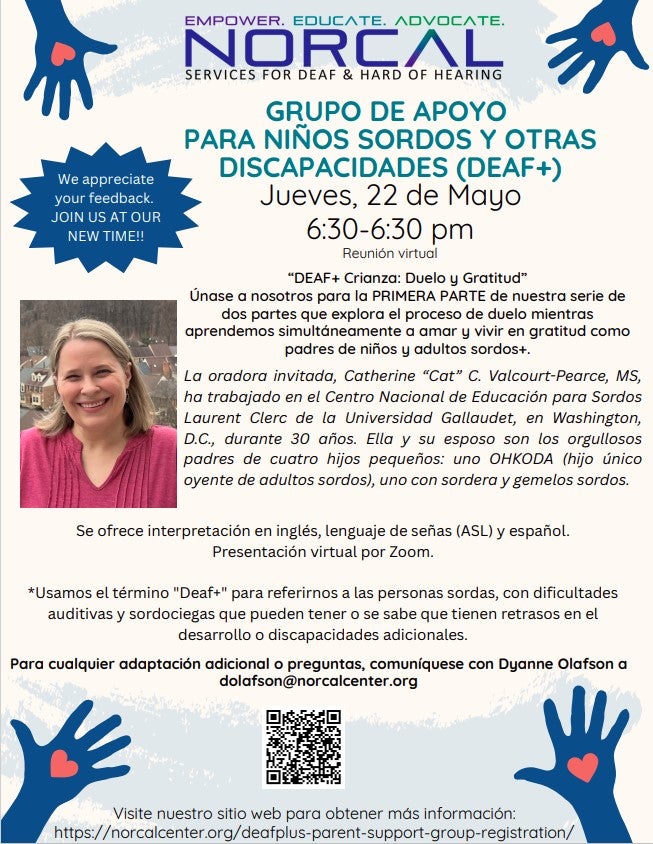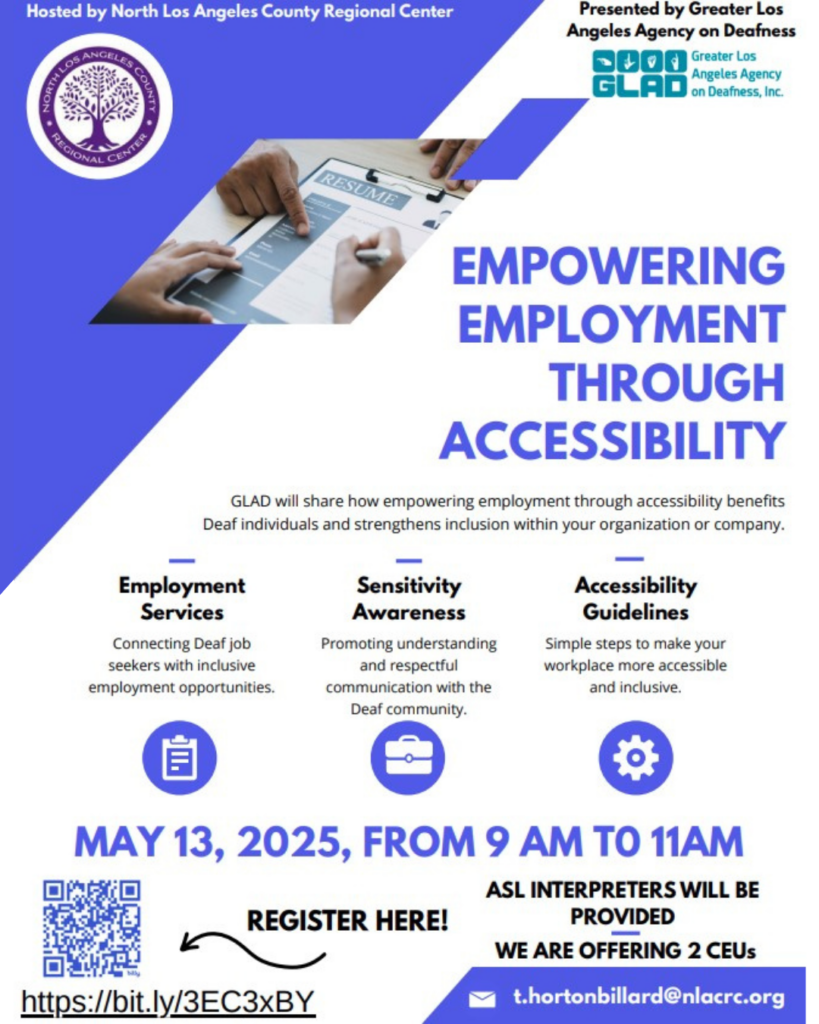Sordo Plus
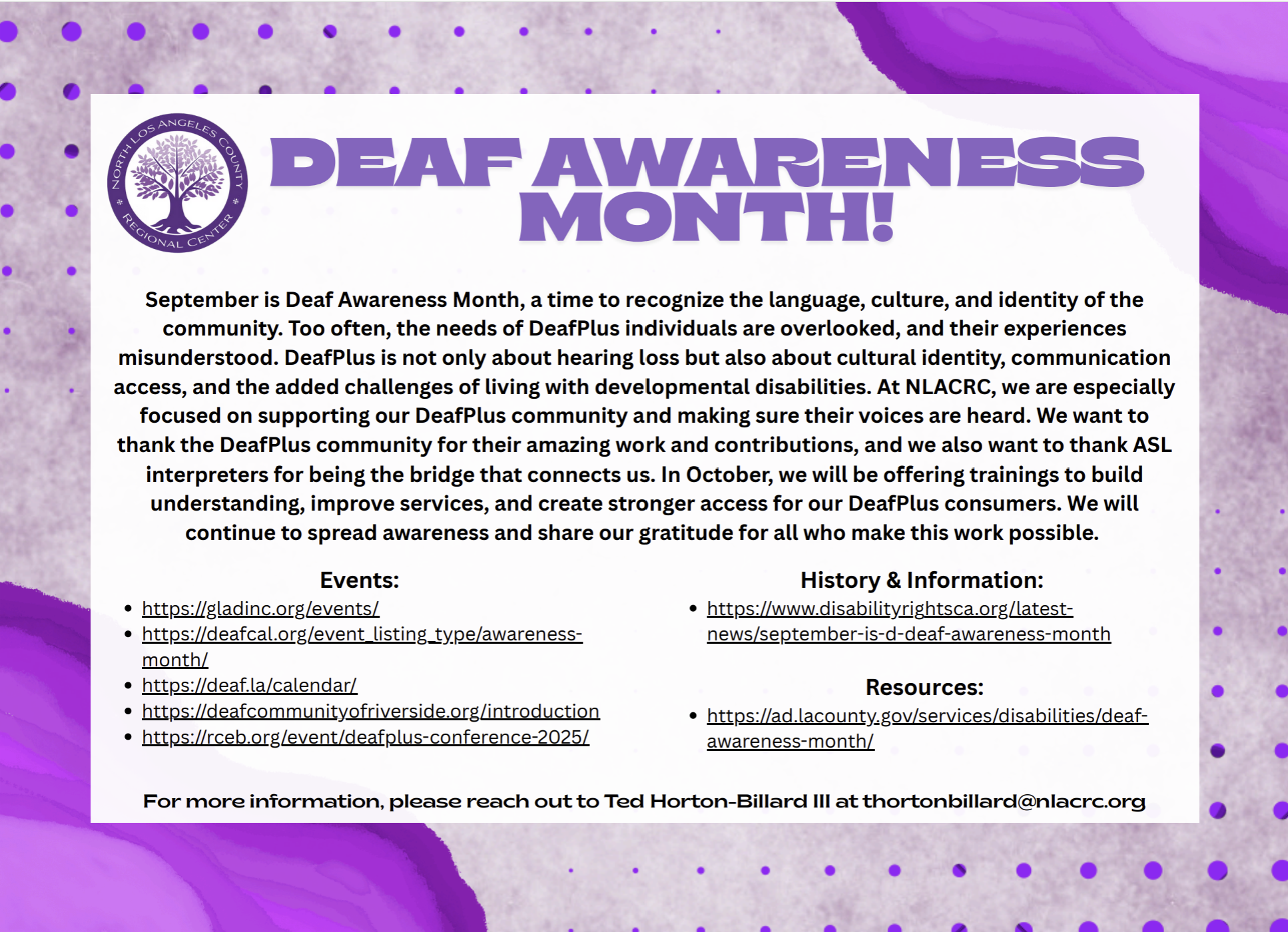
Download the flyer here: DEAF AWARENESS MONTH
- Sordera 101
- Lenguaje de señas americano
- Evento
- Intervención temprana
- Educación
- Red de apoyo para padres
- Servicios de defensa
- Más recursos
Sordera 101
What is DeafPlus?
DeafPlus refers to individuals who are Deaf or Hard of Hearing (DHH) and also have one or more additional disabilities. These disabilities can include intellectual disabilities, cerebral palsy, autism, epilepsy, or other medical and physical conditions that affect their daily life and communication. Because of these additional challenges, people who are DeafPlus may need specialized support beyond what is typically provided for those who are only Deaf or Hard of Hearing.
DeafPlus & the Lanterman Act
In California, the Lanterman Act ensures that individuals with developmental disabilities can receive services through Regional Centers. However, being only Deaf or Hard of Hearing does not qualify someone for these services. To be eligible, a person must have a developmental disability recognized under the Lanterman Act. If a Deaf or Hard of Hearing person also has one of these qualifying disabilities, they are considered DeafPlus and may be eligible for Regional Center services.
What is the Difference Between ASL and Deaf Interpreters?
ASL Interpreter (Hearing Interpreter)
An ASL Interpreter is a hearing person who is fluent in American Sign Language (ASL) and English. They interpret between spoken English and ASL for Deaf and hearing people to communicate. ASL Interpreters are trained professionals who work in many settings, such as schools, hospitals, and meetings.
Deaf Interpreter (DI)
A Deaf Interpreter (DI) is a Deaf or Hard of Hearing person who is specially trained to interpret. They work alongside an ASL Interpreter to help make communication clearer for Deaf individuals who:
· Use a different sign language or home signs.
· Have limited exposure to ASL.
· Have additional disabilities that affect communication.
· Need a more visual or adapted way of signing.
How They Work Together
In some situations, a team of interpreters is needed. The ASL Interpreter translates spoken English into ASL, and the Deaf Interpreter then adapts it to match the Deaf person’s specific language needs. This ensures the message is clear and accessible.
Comprender a las personas sordas y con dificultades auditivas (DHH)
¿Qué es la cultura sorda?
La cultura sorda abarca las creencias sociales, los comportamientos, las expresiones artísticas, las tradiciones literarias, la historia, los valores y las instituciones compartidas de las comunidades moldeadas por la sordera, donde los lenguajes de señas sirven como la forma principal de comunicación.
Hola:
Sordo: este término se refiere a personas que tienen poca o ninguna audición y que a menudo utilizan el lenguaje de señas como su principal medio de comunicación. Muchos miembros de la comunidad sorda consideran su sordera no como una discapacidad, sino como una identidad cultural única. Las personas sordas suelen tener su propio lenguaje distintivo (por ejemplo, el lenguaje de señas estadounidense) y sus propias prácticas sociales.
Hipoacusia: este término describe a las personas que tienen distintos grados de pérdida auditiva pero que aún pueden depender del lenguaje hablado para comunicarse. Las personas con hipoacusia pueden usar audífonos u otras tecnologías de asistencia para escuchar y comprender el habla. La comunidad de personas con hipoacusia a menudo abarca una amplia gama de capacidades auditivas y preferencias de comunicación.
Tanto “sordo” como “con problemas de audición” son términos generales que abarcan una comunidad diversa de personas con diferentes experiencias, identidades y métodos de comunicación.
SordoPlus:
DeafPlus: En las categorías más amplias de sordos y personas con problemas de audición, “DeafPlus” se refiere a personas sordas que tienen discapacidades adicionales. Este término es importante para comprender las diversas necesidades de los consumidores dentro de la comunidad sorda. En particular, las personas que participan en DeafPlus pueden tener discapacidades reconocidas por la Ley Lanterman, lo que las califica para recibir servicios del Centro Regional.
Es importante tener en cuenta que si un consumidor es sordo pero no tiene una discapacidad según la Ley Lanterman, no sería elegible para estos servicios específicos. Por lo tanto, DeafPlus sirve como una designación importante para destacar a aquellos en la comunidad que requieren apoyo adicional debido a sus desafíos combinados.
APRENDIENDO EL LENGUAJE DE SEÑAS AMERICANO (ASL):
Aprender el lenguaje de señas americano (ASL) requiere tiempo, paciencia, práctica y sentido del humor. Si usted es padre o madre de un niño al que recientemente se le ha diagnosticado sordera o problemas de audición, puede solicitar instrucción en ASL al sistema de intervención temprana de su hijo. Los sistemas de intervención temprana están diseñados para ayudar a su hijo a desarrollarse en todas las áreas y para brindar servicios a las familias para que puedan apoyar a su hijo. Hay más información disponible en Lenguaje de señas para padres.
Los signos individuales son relativamente fáciles de aprender. Como cualquier idioma hablado, el ASL tiene sus propias reglas gramaticales y sintácticas. Puede llevar un año o más aprender suficientes signos para una comunicación básica y poder expresarlos con comodidad. Algunas personas aprenden los signos más lentamente que otras y, si ese es tu caso, no te desanimes. Cada persona aprende el lenguaje de signos a su propio ritmo. Ten paciencia y lograrás aprender el idioma. ¡Las recompensas bien valdrán el esfuerzo!
Puedes empezar a aprender ASL asistiendo a una clase de lenguaje de señas ofrecida por organizaciones, empresas, colegios comunitarios o universidades. También puedes ampliar tu conocimiento de ASL practicando tus señas con personas sordas o con problemas de audición que también conozcan ASL. Por lo general, las personas que conocen ASL son pacientes a la hora de mostrar a los nuevos usuarios de lenguaje de señas cómo hacer señas de distintas cosas, la forma correcta de hacer algo y, por lo general, harán las señas más despacio para que tú también puedas entenderlos. También están dispuestos a repetir palabras o afirmaciones si no las entiendes la primera (o incluso la segunda) vez.
El ASL es un lenguaje visual. Con el lenguaje de señas, el cerebro procesa la información lingüística a través de los ojos, y las expresiones faciales y los movimientos corporales desempeñan un papel importante en la transmisión de información. Es posible hacer señas sin utilizar expresiones faciales ni movimientos corporales, pero hacerlo puede transmitir un mensaje contradictorio, resultar confuso o malinterpretarse. También resultará extraño o poco natural para los hablantes nativos.
El lenguaje de señas no es un idioma universal: cada país tiene su propio lenguaje de señas y las regiones tienen dialectos, al igual que muchos idiomas que se hablan en todo el mundo. Si viajaras a otro estado y tuvieras la oportunidad de hablar por señas con una persona que sabe ASL, podrías notar que usa algunos signos de manera diferente a ti. Estos signos se conocen como signos “regionales” y puedes pensar en ellos como el equivalente de un “acento”. Esto no significa que las personas en tu estado usen signos incorrectos. Es solo una variación normal del ASL y estos signos regionales le dan un toque especial a tu comprensión del ASL.
Cuando no conoces el signo de algo, deletrea la palabra o las palabras (lo que se denomina “deletreo con los dedos”). Cuando descubres que no hay un signo para una palabra, no debes inventar ni crear un signo nuevo. Hacerlo puede violar las reglas gramaticales del lenguaje de señas o puede resultar ofensivo sin querer.
La velocidad no es crucial en el lenguaje de señas. Es más importante hacer las señas con claridad, incluso si tienes que hacerlo a un ritmo más lento. Cuando la gente te pide que repitas lo que has dicho, es una señal de que debes ir más despacio e intentar hacer las señas con la mayor claridad posible. No te sientas avergonzado si haces las señas lentamente. Es importante transmitir tu mensaje, conectar con la otra persona y ser comprendido. No hay atajos para una comunicación eficaz.
¡Disfruta el viaje de aprender ASL!
Learn ASL
Hablantes de español
Manos Tierra
Otros recursos de ASL
PROGRAMA DE INTERVENCIÓN TEMPRANA (START EARLY) PARA NIÑOS SORDOS MENORES DE 3 AÑOS:
EDUCACIÓN ESPECIAL PARA ESTUDIANTES SORDOS+ (DE 3 A 21 AÑOS):
 Departamento de Educación de California
Departamento de Educación de California
 Declaración de derechos de los niños sordos y con problemas de audición
Declaración de derechos de los niños sordos y con problemas de audición
 Obligaciones de las escuelas públicas en virtud de la Sección 504 y la ADA
Obligaciones de las escuelas públicas en virtud de la Sección 504 y la ADA
 Otras oportunidades educativas y obligaciones de la ADA para escuelas, clases o programas privados
Otras oportunidades educativas y obligaciones de la ADA para escuelas, clases o programas privados
 Educación primaria y secundaria: recursos adicionales
Educación primaria y secundaria: recursos adicionales
 Derechos y responsabilidades de la educación especial
Derechos y responsabilidades de la educación especial
 Derechos de los padres
Derechos de los padres
 Conceptos básicos del IEP
Conceptos básicos del IEP
 Plan de comunicación para estudiantes con DHH
Plan de comunicación para estudiantes con DHH
 Conceptos básicos de la transición
Conceptos básicos de la transición
Hablantes de español
Aplicaciones de cuentos de hadas VL2
Manos Tierra
Otros recursos de ASL
LAUSD
 Low Vision/Blind Services | Early Childhood Special Education, Early Start Low Incidence
Low Vision/Blind Services | Early Childhood Special Education, Early Start Low Incidence
 Early Start Low Incidence/Deaf Education Services | Early Childhood Special Education
Early Start Low Incidence/Deaf Education Services | Early Childhood Special Education
 Deaf Education Services Pamphlet
Deaf Education Services Pamphlet
 Servicios de Educacion para Sordos
Servicios de Educacion para Sordos
 Low Vision/Blind Educational Services
Low Vision/Blind Educational Services
 Servicios de Educacion Para Sordos
Servicios de Educacion Para Sordos
Red de apoyo para padres
If you have a child who is DeafPlus or know someone who does, this is a great chance to learn about available resources and support. You are not alone—we are here to help you find the services and assistance you need!
Servicios de defensa
Más recursos
Deaf+ Events
No events found.
